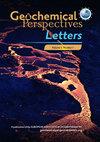Martian core composition from experimental high-pressure metal-silicate phase equilibria
IF 3.7
1区 地球科学
Q1 GEOCHEMISTRY & GEOPHYSICS
引用次数: 5
Abstract
Current Martian core composition models suggest an iron-rich core alloyed with 10 to 20 wt. % of sulfur. Although Mars is more oxidised than Earth, oxygen is usually discarded as a potential light element candidate, since its dissolution into iron is negligible at the pressures and temperatures prevailing during Mars ’ s primitive differentiation. However, it has recently been shown that oxygen interacts with the sulfur in the metal, which dramatically increases its solubility. Here, we investigated this novel process by carrying out metal-silicate equilibration experiments between 2 and 12 GPa, and 1673 and 2473 K, using piston-cylinder and multi-anvil presses. The experimental results show that oxygen was systematically incorporated in the metallic phase alongside sulfur, and a thermodynamic model was developed to para-metrise this interaction. The oxygen-sulfur interaction parameter arising from those thermodynamic equations was fitted and used in a multi-stage core modelling simulation. We found that a Martian core containing 14 to 19 wt. % S (maximum permissible concentration according to cosmochemical constraints) will also contain between 1.3 and 3.5 wt. % O. This would help to match the Martian core density estimate while being cosmochemically consistent. by High-pressure, high-temperature metal-silicate equilibration experiments were out on at The and on in was measured. Using thermodynamic modelling, we parametrised interaction from the experimental data and tested the robustness of the model to validate its predictive potential. We then applied our model to constrain the composition of the Martian core using multi-stage core formation modelling.实验高压金属硅酸盐相平衡的火星核心成分
目前的火星核心成分模型表明,富含铁的核心含有10-20重量%的硫。尽管火星的氧化程度比地球高,但氧通常被视为一种潜在的轻元素候选者而被丢弃,因为在火星原始分化期间的压力和温度下,它溶解成铁的程度可以忽略不计。然而,最近有研究表明,氧与金属中的硫相互作用,这大大增加了其溶解度。在这里,我们通过使用活塞缸和多砧压机在2和12GPa以及1673和2473K之间进行金属硅酸盐平衡实验来研究这种新工艺。实验结果表明,氧与硫一起系统地结合在金属相中,并建立了热力学模型来估计这种相互作用。拟合了由这些热力学方程产生的氧硫相互作用参数,并将其用于多级堆芯建模模拟。我们发现,含有14至19 wt.%S(根据宇宙化学约束的最大允许浓度)的火星核心也将含有1.3至3.5 wt.%O。这将有助于匹配火星核心密度估计,同时保持宇宙化学一致。通过高压、高温金属硅酸盐的平衡实验,对温度进行了测定。使用热力学建模,我们根据实验数据对相互作用进行了参数化,并测试了模型的稳健性,以验证其预测潜力。然后,我们应用我们的模型,使用多阶段地核形成模型来约束火星地核的组成。
本文章由计算机程序翻译,如有差异,请以英文原文为准。
求助全文
约1分钟内获得全文
求助全文
来源期刊

Geochemical Perspectives Letters
Earth and Planetary Sciences-Geochemistry and Petrology
CiteScore
7.00
自引率
2.00%
发文量
42
审稿时长
15 weeks
期刊介绍:
Geochemical Perspectives Letters is an open access, internationally peer-reviewed journal of the European Association of Geochemistry (EAG) that publishes short, highest-quality articles spanning geochemical sciences. The journal aims at rapid publication of the most novel research in geochemistry with a focus on outstanding quality, international importance, originality, and stimulating new developments across the vast array of geochemical disciplines.
 求助内容:
求助内容: 应助结果提醒方式:
应助结果提醒方式:


